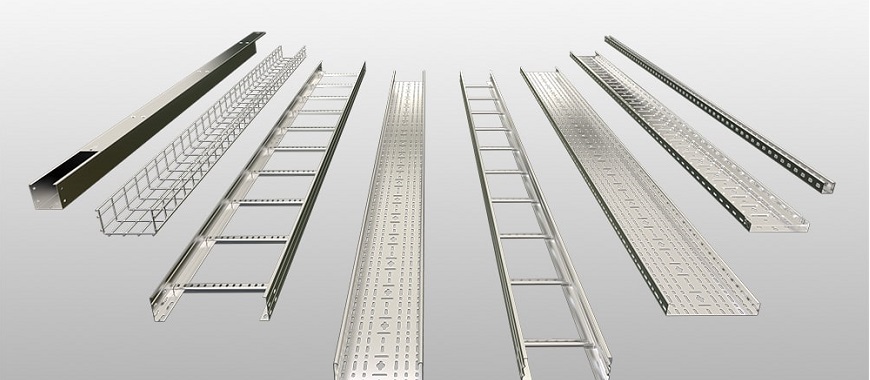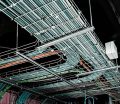
Cable tray feet are essential components in ensuring stable and efficient cable management systems. They provide a solid foundation for various cable trays, improving structural integrity and safety during installations. These feet are designed to support different types of cable trays, including industrial cable trays, wire mesh cable trays, enclosed cable trays, wire cable trays, and electrical wire trays. By enhancing the stability of these trays, cable tray feet prevent shifting, reduce strain on cables, and ensure proper alignment. Their use is especially critical in complex setups where cables need to remain secure and organized. Understanding the role of cable tray feet helps optimize cable management systems, ensuring reliability and long-term performance in diverse environments.
Types of Cable Trays and Their Compatibility with Cable Tray Feet
Cable tray feet are essential components that provide stability and support for various types of cable trays. Their compatibility with different tray systems ensures efficient cable management in diverse environments. Each type of cable tray benefits uniquely from the use of cable tray feet, enhancing functionality and installation reliability.
Industrial Cable Tray Feet for Heavy-Duty Applications
Description of Cable Tray Feet Designed for Industrial Use
Industrial cable tray feet are engineered to support heavy-duty trays used in industrial settings. These feet ensure the trays can withstand high loads and demanding conditions, including exposure to extreme temperatures, vibrations, and corrosive environments. Constructed from durable materials like galvanized steel or reinforced plastics, these feet maintain structural integrity over time.
Benefits of Durable Feet for Heavy-Duty Environments
- Enhanced Load Capacity: Industrial cable tray feet are capable of supporting substantial weights, ensuring no sagging or structural compromise occurs.
- Corrosion Resistance: Feet with specialized coatings resist rust and corrosion caused by chemicals and weather exposure.
- Temperature Durability: Designed to withstand extreme heat or cold, they remain functional in industrial applications.
- Reduced Maintenance Needs: Durable materials extend the lifespan of the entire cable tray system, requiring fewer replacements.
- Safety Compliance: Industrial-grade feet meet safety standards, reducing the risk of accidents caused by instability.
Wire Mesh Cable Tray Feet for Versatile Setups
Importance of Stability in Wire Mesh Cable Trays
Wire mesh cable trays are lightweight and adaptable but require stable support to prevent movement during installation. Cable tray feet provide a solid base, allowing these trays to be used in diverse configurations.
How Cable Tray Feet Improve Installation Flexibility
- Customizable Heights: Adjustable feet enable installations in uneven areas or at varying elevations.
- Modular Support: Easily relocatable cable tray feet adapt to changing layouts or expansions.
- Quick Installation: Lightweight wire mesh trays combined with compatible feet allow for efficient setup.
- Enhanced Ventilation: Feet elevate trays, ensuring airflow around cables to reduce overheating risks.
- Reduced Cable Stress: Stable feet minimize vibrations, preventing wear and tear on cables.
Enclosed Cable Tray Feet for Electrical Safety
Applications of Enclosed Cable Trays in Sensitive Environments
Enclosed cable trays are commonly used in environments requiring enhanced electrical safety, such as hospitals, data centers, or industrial facilities. Proper support from cable tray feet ensures these trays remain secure, reducing the likelihood of electrical hazards.
How Cable Tray Feet Enhance Safety and Prevent Movement
- Electrical Insulation: Feet constructed from non-conductive materials prevent electrical interference.
- Fire Resistance: Feet with fire-retardant properties improve safety in high-risk environments.
- Movement Prevention: Anti-slip features keep trays securely in place, even under heavy loads.
- Dust Control: Elevated trays minimize dust accumulation around electrical components.
- Regulatory Compliance: Designed to meet safety standards for electrical installations.
Cable Tray Waterfall and Feet Integration
Using Cable Tray Feet in Complex Installations Like Cable Waterfalls
Cable waterfalls require precise support to guide cables downward without tangling or overstretching. Cable tray feet provide the stability necessary to maintain proper tray positioning.
Ensuring Proper Support and Alignment
- Structural Integrity: Feet designed for complex installations prevent misalignment and maintain tray angles.
- Simplified Installation: Modular feet allow for quick setup and adjustments in intricate layouts.
- Cable Protection: Stable trays reduce cable stress, preventing wear and tear.
- Aesthetic Organization: Feet keep trays aligned, enhancing the visual appeal of exposed installations.
- Improved Accessibility: Raised tray systems simplify cable management and future maintenance.
Rooftop Cable Tray Sizes and Installation Guidelines Explained
Key Features and Benefits of Cable Tray Feet
Cable tray feet come with various features that enhance their utility in different cable management scenarios. Understanding these features helps in selecting the right feet for specific applications.
Materials Used in Cable Tray Feet
- Steel: Durable and corrosion-resistant, ideal for industrial and outdoor use.
- Rubber: Provides vibration dampening and slip resistance, suitable for sensitive environments.
- Composite Materials: Lightweight yet strong, combining the best properties of metals and plastics.
- Plastic Coatings: Protect against chemical corrosion and weather damage.
- Zinc Coatings: Offer additional resistance to rust and wear.
Adjustable Features for Customizable Installation
- Height Adjustment: Enables leveling of trays on uneven surfaces.
- Swiveling Bases: Allow feet to accommodate angled or curved tray installations.
- Expandable Sections: Fit trays of different widths without replacing components.
- Locking Mechanisms: Prevent accidental shifts during operation.
- Compact Design: Simplifies integration with other tray components.
Weather and Corrosion Resistance for Long-Term Durability
- Electro Zinc Coating: Prevents rust in humid or outdoor environments.
- UV Resistance: Protects against sunlight exposure in rooftop setups.
- Non-Corrosive Materials: Essential for chemical processing plants.
- Waterproof Seals: Prevent moisture from entering critical components.
- Temperature Resistance: Designed to withstand freezing or extreme heat.
Rubber Feet for Cable Tray: Advantages and Applications
How Rubber Feet for Cable Tray Reduce Vibrations and Enhance Grip
Rubber cable tray feet for cable tray are critical in environments with high vibration or movement. Their anti-slip properties ensure stability and reduce noise caused by equipment operation.
Recommended Environments for Using Rubber Feet
- Industrial Facilities: Reduce vibrations from heavy machinery.
- Rooftops: Prevent slippage on uneven or slanted surfaces.
- Wall-Mounted Setups: Stabilize trays attached to vertical structures.
- Marine Applications: Withstand movement from waves or vibrations.
- Data Centers: Minimize vibrations that could disrupt sensitive equipment.
Maintenance Tips for Prolonging the Life of Rubber Feet
- Regular Cleaning: Remove dust and debris that can reduce grip.
- Avoid Overloading: Follow weight recommendations to prevent compression damage.
- Inspect for Wear: Replace feet showing signs of cracking or deformation.
- Store Correctly: Protect unused rubber feet from direct sunlight or extreme temperatures.
- Use Compatible Cleaners: Avoid harsh chemicals that can degrade rubber materials.
NEC Cable Tray Fill Requirements: A Comprehensive Guide
Cable Tray Feet Installation Best Practices
Proper installation of cable tray feet ensures stability and efficiency in cable management systems. Following best practices enhances the safety and longevity of your setup.
Suggested Depth and Width Options for Optimal Compatibility
Choosing the right dimensions for cable tray feet is crucial for stability and support. Depth and width should match the tray type and application needs.
- Depth Options:
Cable tray feet are typically compatible with depths of 2, 4, and 6 inches. Deeper trays require feet with greater structural integrity.- 2-inch depth: Ideal for lightweight setups, such as low-volume network cabling.
- 4-inch depth: Commonly used in medium-load scenarios, including office or light industrial applications.
- 6-inch depth: Designed for heavy-duty industrial uses, handling large cables and increased weight.
- Width Options:
Tray widths typically range from 4 to 12 inches, requiring corresponding foot sizes for compatibility.- 4-inch trays: Suitable for compact installations with minimal space requirements.
- 6 to 8-inch trays: Provide versatility for a variety of cables.
- 12-inch trays: Best for large-scale industrial or electrical installations.
NEC-Approved Guidelines for Cable Tray Feet Placement
Adhering to NEC standards ensures safe and compliant installations. Cable tray feet must be placed to support trays securely.
- Spacing Requirements: Place feet at intervals recommended by NEC guidelines, ensuring load distribution and preventing tray sagging.
- Material Standards: Feet must meet NEC criteria for material durability and non-conductivity, especially in electrical installations.
- Grounding Compliance: Ensure cable tray feet are compatible with grounding systems when necessary, enhancing electrical safety.
Importance of Adding Support at Five-Foot Increments
Adding support at regular intervals prevents stress and maintains the integrity of the system.
- Uniform Weight Distribution: Spacing feet every five feet prevents overloading at single points.
- Enhanced Stability: Regular intervals reduce vibrations and tray movement.
- Cable Protection: Proper support minimizes bending or sagging, protecting cables from damage.
- Simplified Maintenance: Clearly defined support points make adjustments or repairs easier.
- Longevity of System: Strategic placement reduces wear on trays and feet, extending their lifespan.
How to Choose the Right Double Layer Cable Tray
Specifications to Consider When Choosing Cable Tray Feet
Understanding key specifications helps ensure that cable tray feet meet your installation requirements and operational demands.
Load-Bearing Capacity Based on Cable Tray Type
The load-bearing capacity of cable tray feet should align with the tray type and cable weight.
- Lightweight Trays: Use feet capable of supporting minimal loads, ideal for network or fiber optic cables.
- Medium-Duty Trays: Require feet designed to handle moderate weights, such as electrical wiring or communication systems.
- Heavy-Duty Trays: Must be paired with feet capable of supporting industrial-grade loads, including metal-clad cabling.
- Dynamic Loads: Feet in environments with frequent vibrations or movement should offer higher load tolerance.
- Safety Margins: Choose feet rated slightly above the expected load to ensure stability during peak demands.
Compatibility with Various Tray Widths
Cable tray feet must fit securely with tray widths to ensure proper alignment and support.
- 4-Inch Widths: Common for compact systems where space is limited.
- 6-Inch Widths: A versatile option for residential or small commercial setups.
- 8-Inch Widths: Balances capacity and size for medium-load scenarios.
- 12-Inch Widths: Preferred for heavy-duty applications requiring larger cable volumes.
- Custom Widths: Adjustable feet accommodate unique tray dimensions in specialized installations.
Finishes Available: Electro Zinc, Powder-Coated Options
The finish on cable tray feet impacts durability and performance in different environments.
- Electro Zinc: Provides corrosion resistance, ideal for outdoor or industrial setups.
- Powder-Coated: Adds a protective layer, offering weather resistance and aesthetic appeal.
- Galvanized Steel: Durable and cost-effective for most installations.
- Non-Metallic Coatings: Suitable for environments requiring non-conductive components.
- Fire-Resistant Finishes: Enhance safety in high-risk environments.
Enhancing Performance with Quality Cable Tray Feet
Investing in high-quality cable tray feet ensures long-term reliability and efficient cable management.
Why Investing in High-Quality Cable Tray Feet Is Essential for Long-Term Reliability
High-quality cable tray feet enhance system stability, safety, and lifespan.
- Durability: Premium materials resist wear, ensuring prolonged use in demanding environments.
- Safety: High-quality feet reduce the risk of tray displacement, preventing accidents or cable damage.
- Efficiency: Reliable feet minimize maintenance needs, saving time and costs.
- Customization: Superior feet offer adjustable features to fit various tray types and installation needs.
- Performance: Enhanced load capacity and resistance to environmental factors ensure consistent functionality.
Real-World Applications Showcasing Their Effectiveness in Industrial and Electrical Installations
Cable tray feet demonstrate their importance in diverse scenarios, proving their versatility and reliability.
- Industrial Plants: Support heavy trays carrying metal-clad and mineral-insulated cables in harsh conditions.
- Data Centers: Provide stable platforms for elevated trays, ensuring proper organization of critical communication cables.
- Construction Sites: Temporary setups use durable feet to maintain cable alignment during project phases.
- Marine Applications: Feet resist saltwater corrosion, stabilizing trays in moving environments.
- Commercial Spaces: Elevated trays supported by quality feet protect cables from pedestrian and vehicle traffic.
FAQs about Cable Tray Feet
Cable tray supports are typically placed at intervals of five feet for optimal stability and weight distribution. This spacing prevents the trays from sagging and ensures cables remain securely in place. However, specific distances may vary depending on the tray type, load requirements, and installation environment. For heavier trays or those carrying larger cable volumes, supports may be spaced closer together to handle the increased weight. On the other hand, lightweight cable trays used for smaller cables may allow for slightly longer intervals. Always consult the manufacturer’s recommendations and local regulations to ensure proper spacing.
The National Electrical Code (NEC) provides guidelines for cable trays to ensure safety and compliance in electrical installations. These standards cover material requirements, load-bearing capacities, grounding needs, and fire resistance. Cable trays must meet specific criteria, including the ability to support their intended load without deformation. They should also be made from materials resistant to environmental factors like corrosion and extreme temperatures. Standards also emphasize proper spacing for supports and secure cable placement. Adhering to these regulations ensures safe and reliable cable management in industrial, commercial, or residential settings.
Cable trays are often considered a more cost-effective option compared to conduit systems. They require less material and reduce installation time, making them a preferred choice for many projects. Unlike conduit, which involves running individual cables through enclosed tubing, cable trays allow for open placement of multiple cables, saving labor costs. Additionally, cable trays provide flexibility, enabling easy access for future modifications or repairs. While the upfront cost of cable trays may vary depending on the material and size, their long-term benefits often outweigh the expenses associated with conduit systems.
Cable tray fittings are essential for creating a functional and adaptable cable management system. The five basic types include:
Elbows: These allow trays to change direction horizontally or vertically, adapting to structural constraints.
Tees: Used to split a tray into two separate paths for branching cable routes.
Crosses: Facilitate the intersection of multiple cable paths, maintaining organized routing.
Reducers: Transition trays from one width to another, accommodating changes in cable volume.
Splice Plates: Connect tray sections securely, ensuring structural continuity and load distribution.
These fittings ensure flexibility and efficiency, making it easier to customize tray systems for different installation needs.

As the editor of GangLong Fiberglass, I have years of experience and in-depth research, focusing on cable tray products, fiberglass solutions, and grille systems. I incorporate years of industry insights and practical experience into every content, committed to promoting the progress of the industry. At GangLong Fiberglass, my commitment is reflected in every product, from innovative cable trays to durable fiberglass solutions and sturdy grille systems. As an authoritative voice in the industry, my goal is to provide valuable information to professionals and businesses and promote forward-looking solutions.


